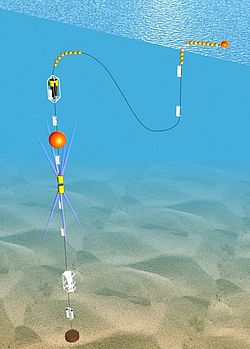A mooring describes a measurement platform with autonomously registering sensors at various depths where the entire platform is “moored” at a fixed location by a bottom weight (often made of discarded railroad wheels). The mooring consists of steel wire or synthetic rope which holds the sensors plus associated buoys made of glass or foam to provide sufficient buoyancy to keep the mooring upright.
Close to the bottom but above the anchor are acoustic releases which allow the controlled release of the instrumented part of the mooring at the end of the scheduled deployment period. The buoyant flotation brings the instruments plus the steel wire to the sea surface to be recovered by the attending research vessel. Most of the data are immediately retrieved on the ship, the instruments are checked, calibrated and refurbished, if necessary, and then redeployed after just a few days in order to obtain longer, uninterrupted time series of oceanic parameters.
This type of instrumentation typically delivers data from preselected depth levels, in most cases temperature, salinity, and current speed and direction. Today’s technology permits long-term records of up to 2 years at sampling intervals of 5 to 10 minutes. These autonomous measurements then allow the analysis of fluctuations on many time scales, from tidal to decadal. Quality assessment of instruments and data is necessary to ensure that any observed trends or long-term fluctuations, for example, are true indicators of climate-relevant changes.
Our working group has many years of experience and expertise in the installation and maintenance of complex mooring platforms. These moorings must be able to withstand the highly corrosive environment and extreme pressure and forces caused by the sea. Technicians, engineers and scientists at GEOMAR work continuously on optimizing the mooring systems in terms of data recording, durability of instruments and data communication. One of the newer developments is the near-realtime remote data transmission, allowing the transfer of data from the sensors to the surface buoy via acoustic modems, then via satellite transmission to the research institute, and initial data assessment and analysis while the measuring platform is still at sea.
Indispensable for this type of work is the capable and effective support at sea through the German fleet of research vessels.



